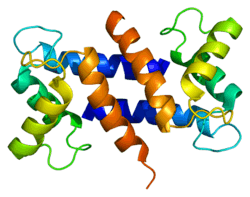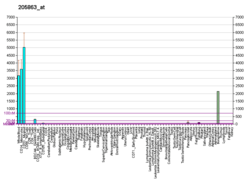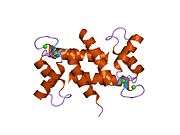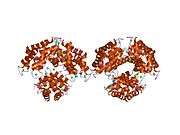S100A12
S100 calcium-binding protein A12 (S100A12) is a protein that in humans is encoded by the S100A12 gene.[3][4] Human S100A12, also known as calgranulin C, was first described in 1995.[5]
The protein encoded by this gene is a member of the S100 family of proteins containing 2 EF-hand calcium-binding motifs.
Function
Generally, S100A12 has a significant anti-infectious and antibacterial role that is related to its ability to uptake ions. For example, it inhibits the spread and virulence of H. pylori.[6][7]
Tissue distribution
Neutrophils and monocytes / macrophages are important source of S100A12 in the cell[8] although some epithelial cells and dendritic cells are capable of its secretion.[9] Some tissues are rich in these cells, and so in this protein. These include the spleen or lungs. It occurs intracellularly but is also produced into extracellular environment where it plays a major role. It occurs in the extracellular environment as homodimer or hexamer.[10]
Clinical significance
Its presence is associated with cardiovascular and kidney diseases.[10] Like other S100 proteins, S100A12 signals through the RAGE receptor and TLR. In general, this signalling leads to cytokine production, chemotaxis and increased oxidative stress. In endothelial cells, this signaling leads to activation of NFκB, under which the production of adhesion molecules such as ICAMs, VCAM or selectins is increased.[10] This protein is proposed to be involved in specific calcium-dependent signal transduction pathways and its regulatory effect on cytoskeletal components may modulate various neutrophil activities.[4]
Cascades that are triggered by interaction of S100A12 with RAGE may play an important role in renal failure in hemodialysis patients. The relationship between S100A12 and renal dialysis mortality rates has been repeatedly reported. S100A12 may play a role in monitoring SLE patients as a marker of kidney damage in glomerulonephritis.[11][12] It is also associated with gastrointestinal diseases. In inflammatory bowel diseases, it significantly correlates with disease activity and, together with other 100S family proteins, can predict disease relapse.[13][14]
References
- GRCh38: Ensembl release 89: ENSG00000163221 - Ensembl, May 2017
- "Human PubMed Reference:". National Center for Biotechnology Information, U.S. National Library of Medicine.
- Wicki R, Marenholz I, Mischke D, Schäfer BW, Heizmann CW (December 1996). "Characterization of the human S100A12 (calgranulin C, p6, CAAF1, CGRP) gene, a new member of the S100 gene cluster on chromosome 1q21". Cell Calcium. 20 (6): 459–64. doi:10.1016/S0143-4160(96)90087-1. PMID 8985590.
- "Entrez Gene: S100A12 S100 calcium binding protein A12".
- Wicki R, Marenholz I, Mischke D, Schäfer BW, Heizmann CW (December 1996). "Characterization of the human S100A12 (calgranulin C, p6, CAAF1, CGRP) gene, a new member of the S100 gene cluster on chromosome 1q21". Cell Calcium. 20 (6): 459–64. doi:10.1016/S0143-4160(96)90087-1. PMID 8985590.
- Yang Z, Yan WX, Cai H, Tedla N, Armishaw C, Di Girolamo N, et al. (January 2007). "S100A12 provokes mast cell activation: a potential amplification pathway in asthma and innate immunity". The Journal of Allergy and Clinical Immunology. 119 (1): 106–14. doi:10.1016/j.jaci.2006.08.021. PMID 17208591.
- Li D, Zeng Z, Yu T, Qin J, Wu J, Song JC, et al. (May 2016). "Expression and clinical implication of S100A12 in gastric carcinoma". Tumour Biology. 37 (5): 6551–9. doi:10.1007/s13277-015-4460-5. PMID 26638166.
- Khorramdelazad H, Bagheri V, Hassanshahi G, Karami H, Moogooei M, Zeinali M, Abedinzadeh M (2015-04-14). "S100A12 and RAGE expression in human bladder transitional cell carcinoma: a role for the ligand/RAGE axis in tumor progression?". Asian Pacific Journal of Cancer Prevention. 16 (7): 2725–9. doi:10.7314/APJCP.2015.16.7.2725. PMID 25854354.
- Bagheri V, Hassanshahi G, Zeinali M, Abedinzadeh M, Khorramdelazad H (March 2016). "Elevated levels of S100A12 in the seminal plasma of infertile men with varicocele". International Urology and Nephrology. 48 (3): 343–7. doi:10.1007/s11255-015-1188-5. PMID 26725070.
- Nazari A, Khorramdelazad H, Hassanshahi G, Day AS, Sardoo AM, Fard ET, et al. (December 2017). "S100A12 in renal and cardiovascular diseases". Life Sciences. 191: 253–258. doi:10.1016/j.lfs.2017.10.036. PMID 29080693.
- Shiotsu Y, Mori Y, Nishimura M, Hatta T, Imada N, Maki N, et al. (January 2013). "Prognostic utility of plasma S100A12 levels to establish a novel scoring system for predicting mortality in maintenance hemodialysis patients: a two-year prospective observational study in Japan". BMC Nephrology. 14 (1): 16. doi:10.1186/1471-2369-14-16. PMC 3552940. PMID 23324110.
- Tydén H, Lood C, Gullstrand B, Jönsen A, Ivars F, Leanderson T, Bengtsson AA (February 2017). "Pro-inflammatory S100 proteins are associated with glomerulonephritis and anti-dsDNA antibodies in systemic lupus erythematosus". Lupus. 26 (2): 139–149. doi:10.1177/0961203316655208. PMID 27407135.
- Foell D, Kucharzik T, Kraft M, Vogl T, Sorg C, Domschke W, Roth J (June 2003). "Neutrophil derived human S100A12 (EN-RAGE) is strongly expressed during chronic active inflammatory bowel disease". Gut. 52 (6): 847–53. doi:10.1136/gut.52.6.847. PMC 1773692. PMID 12740341.
- Wright EK, De Cruz P, Gearry R, Day AS, Kamm MA (September 2014). "Fecal biomarkers in the diagnosis and monitoring of Crohn's disease". Inflammatory Bowel Diseases. 20 (9): 1668–77. doi:10.1097/MIB.0000000000000087. PMID 24918319.
Further reading
- Roth J, Vogl T, Sorg C, Sunderkötter C (April 2003). "Phagocyte-specific S100 proteins: a novel group of proinflammatory molecules". Trends in Immunology. 24 (4): 155–8. doi:10.1016/S1471-4906(03)00062-0. PMID 12697438.
- Guignard F, Mauel J, Markert M (July 1995). "Identification and characterization of a novel human neutrophil protein related to the S100 family". The Biochemical Journal. 309 ( Pt 2) (2): 395–401. doi:10.1042/bj3090395. PMC 1135745. PMID 7626002.
- Schäfer BW, Wicki R, Engelkamp D, Mattei MG, Heizmann CW (February 1995). "Isolation of a YAC clone covering a cluster of nine S100 genes on human chromosome 1q21: rationale for a new nomenclature of the S100 calcium-binding protein family". Genomics. 25 (3): 638–43. doi:10.1016/0888-7543(95)80005-7. PMID 7759097.
- Yamamura T, Hitomi J, Nagasaki K, Suzuki M, Takahashi E, Saito S, et al. (April 1996). "Human CAAF1 gene--molecular cloning, gene structure, and chromosome mapping". Biochemical and Biophysical Research Communications. 221 (2): 356–60. doi:10.1006/bbrc.1996.0600. PMID 8619860.
- Marti T, Erttmann KD, Gallin MY (April 1996). "Host-parasite interaction in human onchocerciasis: identification and sequence analysis of a novel human calgranulin". Biochemical and Biophysical Research Communications. 221 (2): 454–8. doi:10.1006/bbrc.1996.0616. PMID 8619876.
- Ilg EC, Troxler H, Bürgisser DM, Kuster T, Markert M, Guignard F, et al. (August 1996). "Amino acid sequence determination of human S100A12 (P6, calgranulin C, CGRP, CAAF1) by tandem mass spectrometry". Biochemical and Biophysical Research Communications. 225 (1): 146–50. doi:10.1006/bbrc.1996.1144. PMID 8769108.
- Hofmann MA, Drury S, Fu C, Qu W, Taguchi A, Lu Y, et al. (June 1999). "RAGE mediates a novel proinflammatory axis: a central cell surface receptor for S100/calgranulin polypeptides". Cell. 97 (7): 889–901. doi:10.1016/S0092-8674(00)80801-6. PMID 10399917.
- Moroz OV, Antson AA, Dodson GG, Wilson KS, Skibshoj I, Lukanidin EM, Bronstein IB (February 2000). "Crystallization and preliminary X-ray diffraction analysis of human calcium-binding protein S100A12". Acta Crystallographica. Section D, Biological Crystallography. 56 (Pt 2): 189–91. doi:10.1107/S0907444999014936. PMID 10666601.
- Moroz OV, Antson AA, Murshudov GN, Maitland NJ, Dodson GG, Wilson KS, et al. (January 2001). "The three-dimensional structure of human S100A12". Acta Crystallographica. Section D, Biological Crystallography. 57 (Pt 1): 20–9. doi:10.1107/S090744490001458X. PMID 11134923.
- Cole AM, Kim YH, Tahk S, Hong T, Weis P, Waring AJ, Ganz T (August 2001). "Calcitermin, a novel antimicrobial peptide isolated from human airway secretions". FEBS Letters. 504 (1–2): 5–10. doi:10.1016/S0014-5793(01)02731-4. PMID 11522286.
- Moroz OV, Antson AA, Dodson EJ, Burrell HJ, Grist SJ, Lloyd RM, et al. (March 2002). "The structure of S100A12 in a hexameric form and its proposed role in receptor signalling". Acta Crystallographica. Section D, Biological Crystallography. 58 (Pt 3): 407–13. doi:10.1107/S0907444901021278. PMID 11856825.
- Strauss GI, Edvinsson L, Larsen FS, Møller K, Knudsen GM (2002). "Circulating levels of neuropeptides (CGRP, VIP, NPY) in patients with fulminant hepatic failure". Neuropeptides. 35 (3–4): 174–80. doi:10.1054/npep.2001.0861. PMID 11884208.
- Maayan C, Becker Y, Gesundheit B, Girgis SI (2002). "Calcitonin gene related peptide in familial dysautonomia". Neuropeptides. 35 (3–4): 189–95. doi:10.1054/npep.2001.0863. PMID 11884210.
- Filipek A, Jastrzebska B, Nowotny M, Kuznicki J (August 2002). "CacyBP/SIP, a calcyclin and Siah-1-interacting protein, binds EF-hand proteins of the S100 family". The Journal of Biological Chemistry. 277 (32): 28848–52. doi:10.1074/jbc.M203602200. PMID 12042313.
- Ryckman C, Robichaud GA, Roy J, Cantin R, Tremblay MJ, Tessier PA (September 2002). "HIV-1 transcription and virus production are both accentuated by the proinflammatory myeloid-related proteins in human CD4+ T lymphocytes". Journal of Immunology. 169 (6): 3307–13. doi:10.4049/jimmunol.169.6.3307. PMID 12218151.
- Foell D, Ichida F, Vogl T, Yu X, Chen R, Miyawaki T, et al. (April 2003). "S100A12 (EN-RAGE) in monitoring Kawasaki disease". Lancet. 361 (9365): 1270–2. doi:10.1016/S0140-6736(03)12986-8. PMID 12699958.
- Foell D, Kucharzik T, Kraft M, Vogl T, Sorg C, Domschke W, Roth J (June 2003). "Neutrophil derived human S100A12 (EN-RAGE) is strongly expressed during chronic active inflammatory bowel disease". Gut. 52 (6): 847–53. doi:10.1136/gut.52.6.847. PMC 1773692. PMID 12740341.






